 T.U.C. Advertisement
T.U.C. Advertisement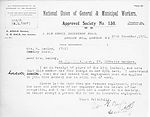 Letter - Approved Society membership
Letter - Approved Society membership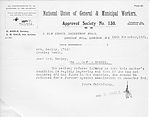 Letter- sickness beneftit
Letter- sickness beneftit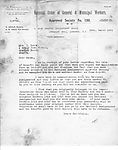 Letter - Approved Society membership
Letter - Approved Society membership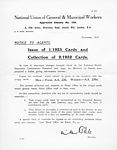 Notice to Approved Society agents
Notice to Approved Society agents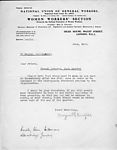 Letter - branch returns
Letter - branch returns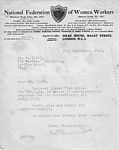 Letter - Approved Society administration expenses
Letter - Approved Society administration expenses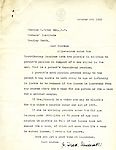 Institute accounts and Approved Society accounts neede to be kept separate
Institute accounts and Approved Society accounts neede to be kept separate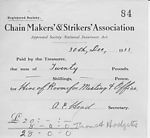 Receipt for hire of rooms
Receipt for hire of rooms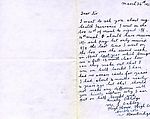 Letter - health insurance enquiry
Letter - health insurance enquiry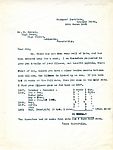 Letter - sickness benefit enquiry
Letter - sickness benefit enquiry 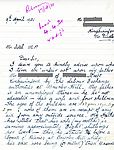 Letter - unemployment benefit disallowed, p1
Letter - unemployment benefit disallowed, p1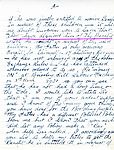 p2
p2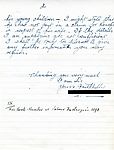 p3
p3

The Workers’ Institute’s link with the trade union movement dates back to a time before it was even built. There was a considerable amount of money left over from the Women Chainmakers’ strike of 1910, which was used to finance the building. The Cradley Heath branch of the National Federation of Women Workers (NFWW) was based there, as was the National Union of General and Municipal Workers (NUGMW) with which it amalgamated in 1921. During the 1930s the Chainmakers’ and Strikers’ Association also moved its official office to the Institute and continued to use it until the union dissolved in 1977.
The original Trustees of the building had all been actively involved in the 1910 strike. They were Mary MacArthur , secretary of the NFWW, Gertrude Tuckwell, president of the Women’s Trade Union League, James Joseph Mallon, secretary of the Anti-Sweating League, Thomas Sitch, secretary of the CMSA and Ruth Tromans, a local chainmaker.
The CMSA held their monthly executive meetings upstairs in the committee room. Annual general meetings of each of the unions were held in the auditorium. Factory secretary meetings, and strike meetings were also held there. During the 1926 General Strike the Institute was the headquarters of the area’s Emergency Strike Committee.
The union office was a very busy one, dealing with the everyday administration of the unions; collection of union subscriptions; payment of union benefits including sickness and unemployment, strike pay and funeral benefits; advice on employment issues and grievance procedures. Many members visited the Institute in person; others sought help in writing. The Museum holds a large number of such letters in its archive, some of which are reproduced here.
Each union’s organisation for the collection and distribution of monies was well established, making it possible for them to be accepted as Approved Societies to administer the requirements of the National Insurance Act of 1911. Workers aged between 16 and 70, earning less than £160 per year, were covered by the scheme. When the scheme was first introduced, men paid 4d (1.6p) per week, women paid 3d (1.25p). Employers contributed 3d (1.25p) for each person and the State added a further 2d (.8p)
Employers held the insurance cards, and stamped them each week. When the cards were full they were collected by the factory secretaries and taken to the Institute to be recorded and forwarded to the Ministry, who in turn credited the society with the value of the stamps. Factory secretaries were paid for each card collected.
Workers visited the Institute to collect their benefit. Providing enough contributions had been made, sickness benefit of 10 shillings (50p) per week was paid to men, and 7s 6d (37p) to women, for the first 13 weeks. The amount was reduced to 5s (25p) for next thirteen weeks for both men and women. A disability pension of 5s (25p) a week was paid if the claimant was still unable to work. A one-off maternity benefit of 30s (£1.50) was paid to the wives of insured men and to women who were insured in their own right. This last was the result of lobbying by Mary MacArthur and was quite revolutionary in that it was paid directly to mothers, including those of illegitimate children. A sanatorium benefit was also paid to anyone needing treatment for consumption (tuberculosis).
The insurance scheme generated a great deal of casework, which between 1912 and early 1933 was dealt with by Charles Sitch, assisted by two secretaries. Albert Head replaced Charles later in 1933. Some examples of casework correspondence are included here.
The Museum has been able to collect oral testimony from several people who remember the Institute as the union office.
Mary Grove, an enamellist at a local company, recalls that in the 1930s, when work was a bit thin on the ground, the women at Ernest Stevens would sometimes be temporarily laid-off or have to go part-time. When this happened Mary used to go to the Institute to collect her labour pay.
Millie Clee, born in Cradley Heath 1917, remembers going to the "stute" to "pay her doctor’s club money every month". She always went in through the side entrance doors and remembers there was "a little room where she used to get her card stamped". She says she paid her doctor’s money until she was married and then, "we had to pay at another chapel, near the police station".
Millie Green, born in 1912, remembers her mother helping with the food for the men who were out of work during the 1921 miners’ strike.
George Pearson recalls that his father, a chainmaker and member of the CMSA, regularly attended meetings at the Institute. During lean times in the chain trade in the 1930s, his father went to the "stute" to collect his unemployment money. As a small boy George remembers walking up the steps at the front of the building, and entering a small office from the front lobby. Inside, he recalls there was a man sitting at a table on which there was a typewriter and tall black telephone. His dad had to sign a book before being given a small sum of money.
Rollover the captions in the box to see the available images in thumbnail format, click the caption to see the full-size image
| Reference: | 704 |
| Keywords: | |
| Archive Ref: | |
| Updated: | Wed 23 Apr 2008 - 1 |
| Interpretation written by | Barbara Harris |
| Author's organisation | |
| Organisation's website |